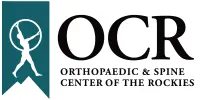Ski season is just around the corner, and if you’re like most Coloradans, you’re probably already checking snow reports and planning your first trip to the mountains. There’s nothing quite like that feeling of carving down fresh powder with the Colorado Rockies stretching out around you.
But here’s what we see every winter at Orthopaedic & Spine Center of the Rockies in Westminster: as soon as the lifts start running, ski and snowboard injuries spike dramatically. The good news? Most of these injuries are completely preventable with the right preparation and smart choices on the mountain.
Colorado Ski Injury Statistics: What You Need to Know
Knee injuries are the most common skiing injury, accounting for 30-40% of all ski accident-related injuries, with the knee being the single most common joint affected, accounting for around 1 in 4 ski injuries.
Common skiing injuries include:
- Knee injuries (ACL tears, MCL tears, meniscus damage)
- Wrist fractures (especially common in snowboarders)
- Shoulder dislocations
- Head injuries and concussions
- Thumb injuries (skier’s thumb)
The American Orthopaedic Society for Sports Medicine reports that snowboarders are more likely to injure their upper body, while skiers tend to experience more knee injuries.
Pre-Season Training: Build Your Foundation
Strength Training for Ski Injury Prevention
Target these key muscle groups:
- Quadriceps and hamstrings (primary ACL protection)
- Glutes (prevent knee valgus collapse)
- Core muscles (overall stability and balance)
- Calves (ankle stability and control)
Recommended exercises:
- Squats and single-leg squats
- Lunges in multiple directions
- Wall sits (build endurance)
- Planks and rotational core work
- Calf raises and balance exercises
Flexibility and Mobility Training
Flexible joints are less prone to injury. Focus on:
- Hip flexor stretches
- IT band mobility
- Ankle dorsiflexion
- Hamstring flexibility
- Thoracic spine rotation
Cardiovascular Conditioning
Fatigue is a major risk factor for ski injuries. Poor cardiovascular fitness leads to:
- Decreased reaction time
- Poor form and technique breakdown
- Reduced muscle protection of joints
- Impaired decision-making
Essential Ski Safety Equipment
Ski and Snowboard Maintenance
Annual equipment checks must include:
- Binding adjustment (based on current weight, boot size, skiing ability)
- Edge sharpening and base repair
- Binding release testing (critical for injury prevention)
- Boot sole inspection and replacement if worn
Protective Gear That Prevents Injuries
Helmets: The CDC reports helmets reduce head injury risk by 60%. Modern ski helmets also provide:
- Better ventilation
- Integrated goggle compatibility
- MIPS technology for rotational impact protection
Wrist Guards:(especially for snowboarders)
Knee Braces: (for those with previous injuries)
Back Protectors: (for aggressive terrain)
Proper Boot Fitting
Ill-fitting boots contribute to:
- Loss of control and precision
- Increased fall risk
- Circulation problems
- Foot and ankle injuries
On-Mountain Safety Strategies
Smart Skiing Behaviors
Start every ski day with:
- Warm-up runs on easy terrain
- Dynamic stretching before first run
- Equipment checks (bindings, boots, poles)
- Mountain condition assessment
Throughout the day:
- Take breaks before fatigue sets in
- Stay within your ability level
- Avoid skiing when tired or in poor visibility
- Maintain proper hydration (Colorado’s altitude accelerates dehydration)
Terrain and Condition Awareness
High-risk scenarios include:
- Icy conditions (increased fall severity)
- Variable snow conditions (require constant adaptation)
- Crowded slopes (collision risk)
- Late-day skiing (fatigue and changing conditions)
Safe Falling Techniques
When you start to fall:
- Fall to the side, not backward
- Keep hands up (don’t try to catch yourself)
- Stay loose if tumbling
- Don’t fight the fall (let it happen)
When to Seek Medical Attention
Immediate Red Flags
Seek emergency care for:
- Joint instability or inability to bear weight
- Significant swelling or deformity
- Severe pain that doesn’t improve with rest
- Head injury symptoms (confusion, nausea, dizziness)
- Loss of sensation or movement
OCR Westminster Ski Injury Care
Our sports medicine specialists provide comprehensive care for winter sports injuries:
Same-day services:
- Orthopedic urgent care for acute injuries
- Advanced imaging (MRI, X-ray, ultrasound)
- Immediate stabilization and pain management
Specialized treatment for:
- Knee injuries and ACL tears
- Concussion management and return-to-sport protocols
- Shoulder dislocations and rotator cuff injuries
- Wrist fractures and hand injuries
Ski Season Preparation: Your Action Plan
6-8 Weeks Before Season
- Begin strength training program
- Schedule equipment tune-up
- Start cardiovascular conditioning
- Address any existing injuries or pain
2-4 Weeks Before Season
- Increase training intensity
- Practice balance and agility exercises
- Ensure proper gear fit
- Consider pre-season physical if you have injury history
Week of First Ski Day
- Taper training intensity
- Hydrate well
- Get adequate sleep
- Plan conservative first days on mountain
Keep Colorado Skiing Safe
At OCR Westminster, we want every Colorado skier and snowboarder to have a safe, enjoyable season. Preparation is your best insurance policy against injury. Whether you need pre-season conditioning advice, injury prevention strategies, or expert care after an injury, our board-certified sports medicine team is here to support you. Click below to request an appointment with one of them:
Remember: the best ski day ends with you planning your next trip to the mountain, not sitting in a medical clinic. Let’s work together to keep you safely on the slopes all season long.
